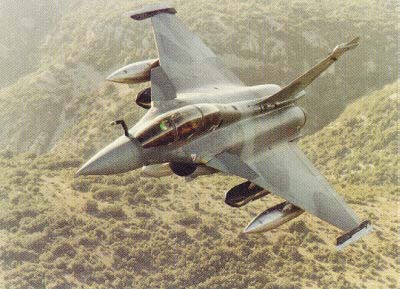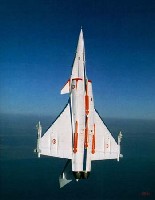Global Aircraft -- Dassault Rafale
|
Aviation Center
US Attack
US Bombers
US Cargo
US Fighters
US Helicopters
US Patrol/Pursuit
US Reconnaissance
US Tankers
US Trainers
US UAV's
US X Planes
Orbiter Vehicles
WWI Aircraft
WWII Aircraft
Airbus
Antonov
Boeing
Dassault
Ilyushin
Kamov
MiG
Mil
Saab
Sukhoi
Tupolev
Yakovlev
Joint/Rest of World
Entertainment Center
Members Center
New Technologies
Contact Us
Extra Navigation
GAC Engine
Dassault Rafale Specifications
Dassault Rafale Features
The Rafale features a delta wing combined with an active forward canard to maximize maneuverability (withstanding 9G or -3G) while maintaining stability in flight; the forward canard also reduces landing speed to 115 knots. The aircraft can operate from 400 meter runways.
The Rafale carries, for the first time in aviation history, an integrated electronic survival system named SPECTRA which features a software-based virtual stealth technology. The most important sensor is the Thales RBE2 passive electronically scanned multi-mode radar. Thales claims to have achieved unprecedented levels of situational awareness through the earlier detection and tracking of multiple air targets for close combat and long-range interception, as well as real time generation of three-dimensional maps for terrain-following and the real time generation of high resolution ground maps for navigation and targeting. However, in those circumstances when signature management is required, the Rafale can use several passive sensor systems. The front-sector electro-optical system or Optroniques Secteur Frontal (OSF), developed by Thales, is completely integrated within the aircraft and can operate both in the visible and infrared wavelengths. The SPECTRA electronic warfare system, jointly developed by Thales and EADS France, provides the aircraft with the highest survivability assets against airborne and ground threats.[10] The real-time data link allows communication not only with other aircraft, but also with fixed and mobile command and control centres. For those missions requiring it, the Rafale will also eventually use the DAMOCLES electro-optical/laser designation pod that brings full day and night LGB capability, though the Arm%uFFFDe de l'Air's current plans call for Rafale to use stand off weapons, and for the LGB role to be handled by Mirage 2000s. The Rafale core systems employ an Integrated Modular Avionics (IMA), called MDPU (Modular Data Processing Unit). This architecture hosts all the core functions of the aircraft as Flight management system, Data Fusion, Fire Control, Man-Machine Interface, etc... The cockpit uses a Martin-Baker Mark 16F "zero-zero" ejection seat, i.e. capable of being used at zero speed and zero altitude. The seat is inclined 29 degrees backwards to improve G force tolerance. The canopy hinges open to the right. An on-board oxygen generating system is provided to eliminate the need for multiple oxygen canisters. The cockpit includes a wide-angle holographic Head Up Display (HUD) and two head-down flat-panel colour multifunction displays ( MFDs). Display interaction is by means of touch input for which the pilot wears silk-lined leather gloves. In addition, in full development, the pilot will have a Helmet-Mounted Display ( HMD). The pilot flies the aircraft with a side-stick controller mounted on his right and a throttle on his left. These incorporate multiple `hands on throttle and stick%u2019 (HOTAS) controls. The Rafale cockpit is also planned to include Direct Voice Input (DVI), allowing for pilot action by voice commands. Although not a true stealth aircraft, the Rafale has reduced radar signature measures like many of its contemporaries such as the Super Hornet and Typhoon. According to Dassault, while most of the stealth design features are classified, extensive use of composite materials and serrated patterns on the trailing edges of the wings and canards help to reduce the radar cross section. Initial deliveries of the Rafale M were to the F1 ("France 1") standard. This meant that the aircraft was suitable for air-to-air combat, replacing the obsolescent F-8 Crusader as the Aviation Navale's carrier-based fighter, but not equipped or armed for air-to-ground operations. Actual deliveries (to Flotille 11 some time after 2007) are to the "F2" standard, giving air-to-ground capability, and replacing the Dassault-Breguet Super Etendard in the ground attack role and the Dassault Etendard IVP in the reconnaissance role. This will leave the Rafale M as the only fixed-wing combat aircraft flown by the Aviation Navale, and plans are to upgrade all airframes to the "F3" standard, with terrain-following 3D radar and nuclear capability, from early in the decade following 2010. The first Rafale C delivered to the Armee de l'Air, in June 2005, was to the "F2" standard, and it is anticipated that upgrades similar to those of the navy will take place in the future. The Rafale replaces the SEPECAT Jaguar, Mirage F1 and the Mirage 2000 in the Armee de l'Air.
Dassault Rafale Background
In the mid 1970s, both the French Air Force (Armee de l'Air) and Navy (Aeronavale) had a requirement (the Navy's being rather more pressing) to find a new generation of fighter (principally to replace AdlA SEPECAT Jaguars and Aeronavale F-8 Crusaders), and their requirements were similar enough to be merged into one project.
The Rafale A technology demonstrator was rolled out in late 1985 and made its maiden flight on 4 July 1986. The SNECMA M88 engines being developed were not considered sufficiently mature for the initial trials programme to be conducted without risk (though their development status has often been underplayed), so the demonstrator flew with General Electric F404-GE-400 afterburning turbofans as used on the F/A-18 Hornet. Production orders were placed in 1988. Further testing continued, including carrier touch-and-go landings and test-flying early M88 engines, before the Rafale A was retired in 1994. Though the Rafale A and British Aerospace EAP were broadly comparable, when the first Eurofighter made its maiden flight in March 1994, pre-series Rafales had been flight-testing for three years, including carrier trials (Rafale C01, Rafale M01, and Rafale B01 first flew in May 1991, December 1991, and April 1993 respectively). Three versions of Rafale were in the initial production order: * Rafale C (Chasseur) Single-seat fighter for the AdA (Armee de l'Air, French Air Force) * Rafale B (Biplace) Two-seat fighter for the AdA * Rafale M (Marine) Single-seat carrier fighter for the Aeronavale The prototype Rafale C flew in 1991, the first of two Rafale M prototypes flew later that year. The prototype Rafale B flew in early 1993, and the second Rafale M prototype flew later that year. Catapult trials were initially carried out between July 13 and August 23, 1992 at NAS Lakehurst in New Jersey, USA and NAS Patuxent River, Maryland, USA, as France had no land-based catapult test facility. The aircraft then undertook trials aboard the carrier Foch. Initially the Rafale B was to be just a trainer, but Gulf War and Kosovo experience showed that a second crewmember is invaluable on strike and reconnaissance missions, and therefore more Rafale Bs were ordered, replacing some Rafale Cs. 60% of the aircraft will be two seaters. A similar decision was made by the Navy, who initially did not have a two-seat aircraft on order; the program nevertheless was stopped. Political and economic uncertainty meant that it was not until 1999 that a production Rafale M flew. At one time the French forces were expected to order 294 Rafales: 232 for the Air Force and 60 for the Navy. But as time passed, these number dropped and to date 120 Rafales have been officially ordered. These are being delivered in three separate batches, the most recent being the December 2004 order for 59 Rafales, though the French Ministry of Defence has revealed that this figure is currently under study and is likely to be reduced to 51 aircraft "for the same overall cost". It was hinted that the sacrifice of 8 aircraft would "allow for the introduction of new sensors developed by the French industry on this batch." The marine version has priority since the aircraft it is replacing are much older Vought F-8 fighters. Service deliveries began in 2001 and the type "entered service" on 4 December 2000, though the first squadron, Flotille 12, did not actually reform until 18 May 2001. The unit embarked on the Charles de Gaulle in 2002, becoming fully operational on 25 June 2004, following an extended opeval (operational evaluation) which included flying limited escort and tanker missions in support of Operation Enduring Freedom over Afghanistan. The Armee de l'Air received its first three Rafale Bs (to F2 standards) in late December 2004. They went to the Centre d'militaires (CEAM) at Mont-de-Marsan for operational evaluation and associated pilot conversion training.The first Armee de l'Air frontline unit, Escadron de Chasse 1/7 Provence, will form at Saint-Dizier during 2006, delayed deliveries having forced some delay to the squadron's stand up date. Full Operational Capability (FOC) was until recently still optimistically scheduled for September 2006, but has now slipped back to mid-2007, when the type should be fully operational as an omni-role fighter/fighter-bomber with MICA air-to-air missiles, SCALP EG cruise missiles, GPS-guided bombs, and laser-guided bombs (LGBs) (though the latter will be designated by other platforms or by ground based systems). | ||||||||||||||||||||||||||||||||||||||



